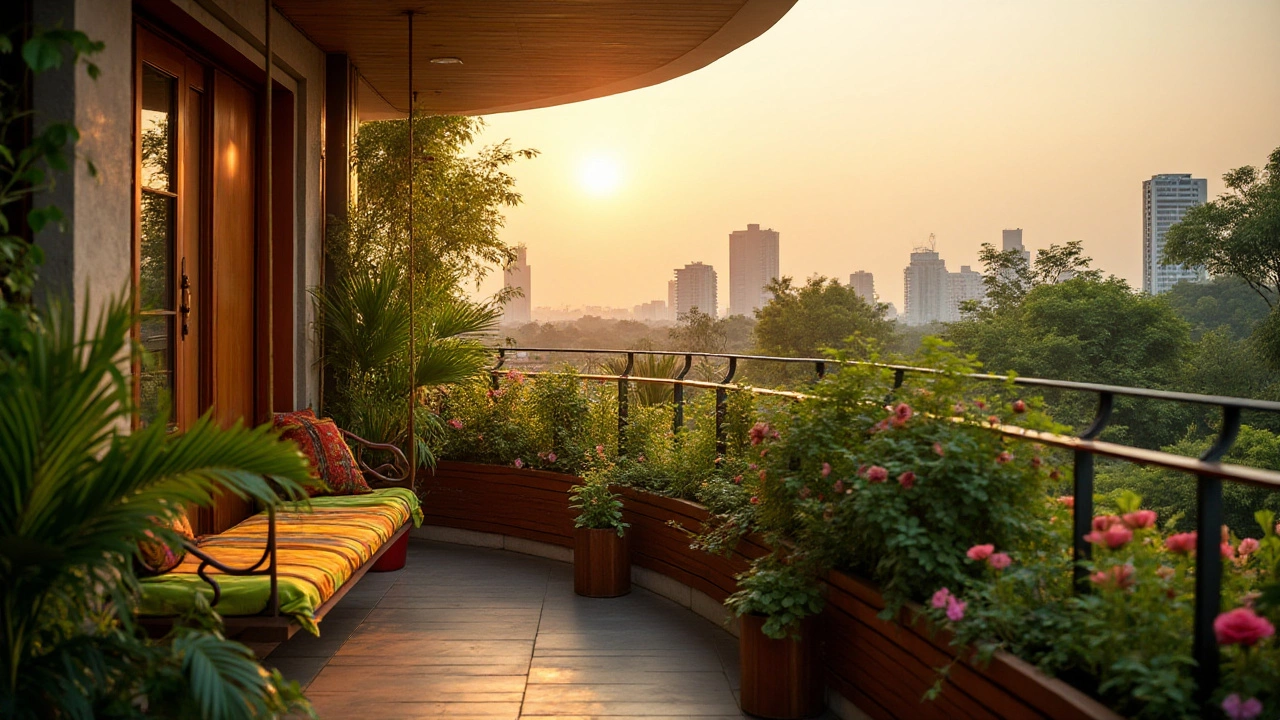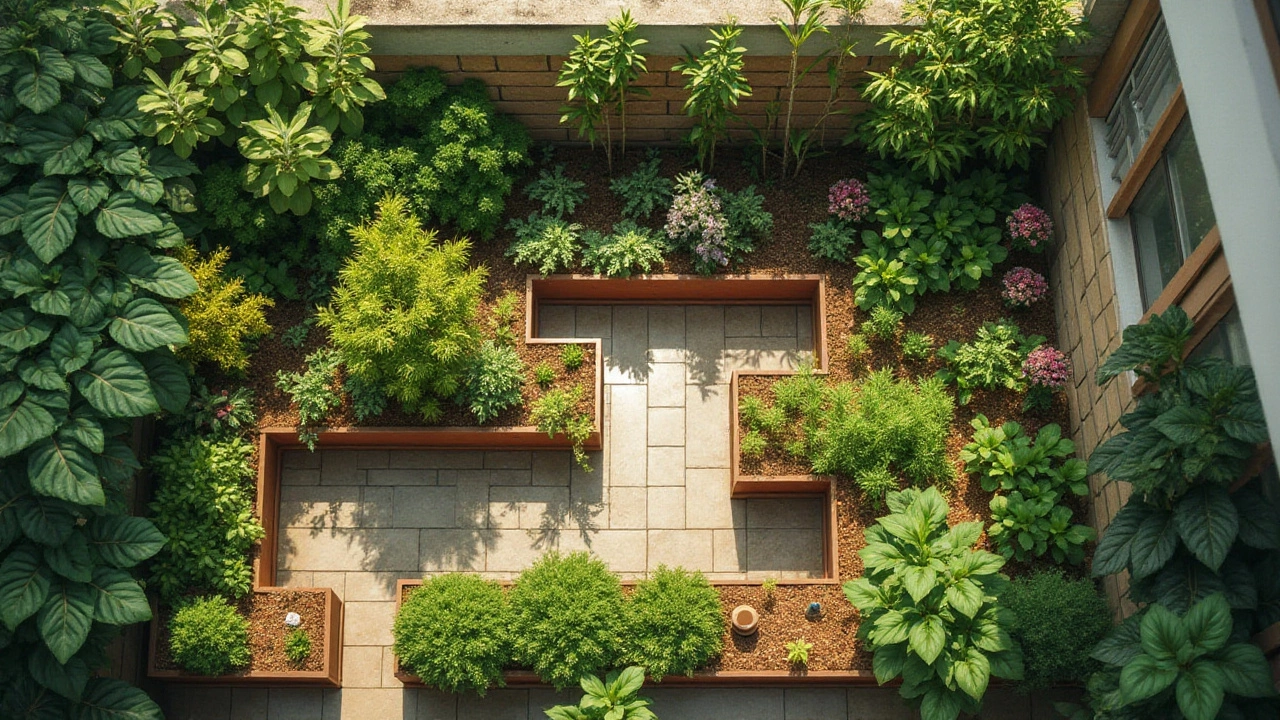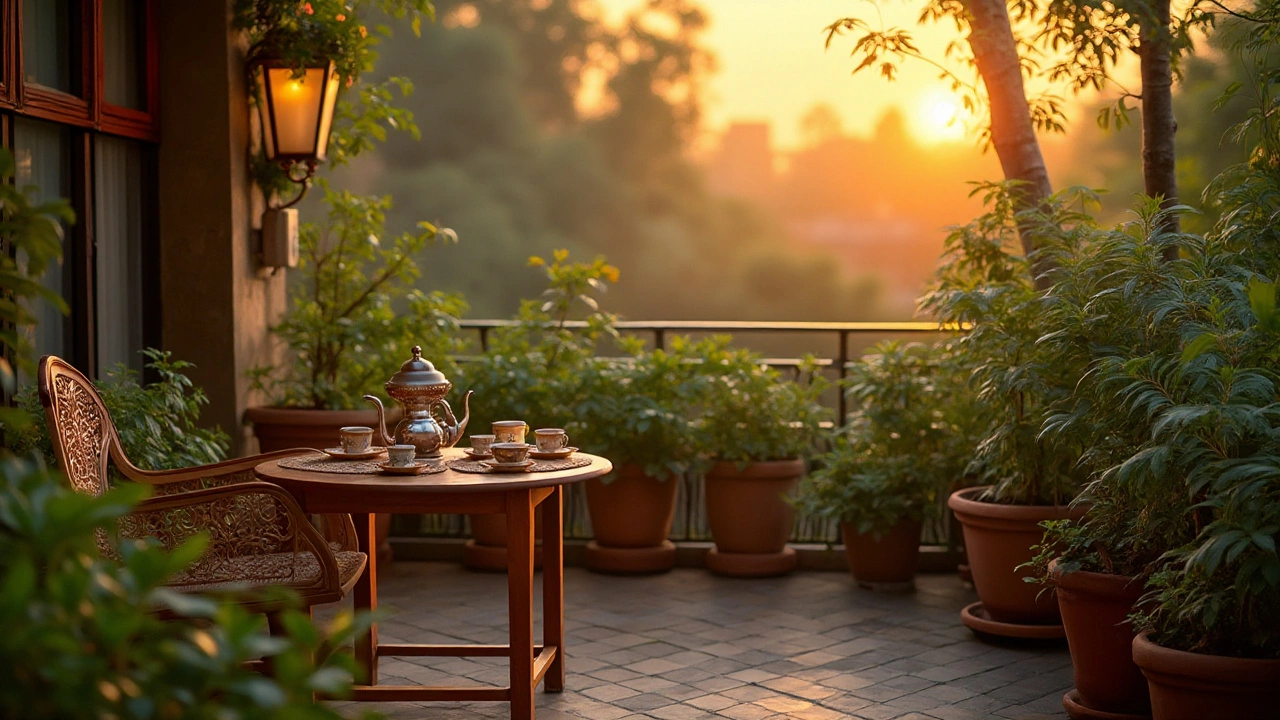Optimal Balcony Directions for Sunlight in Your Garden

Creating a thriving garden on your balcony involves more than just choosing the right plants. To make your garden flourish, understanding the role of sunlight and how different balcony orientations affect it is essential.
Balcony gardening isn't just an urban trend—it's a creative solution to space constraints and an opportunity to indulge in nature’s bounty right at your doorstep. The direction your balcony faces can dramatically influence how much and what kind of sunlight your plants receive, which directly affects their growth and overall health.
Whether you're aiming for a lush, green sanctuary or hoping to supply your kitchen with fresh produce, the path to success begins with positioning. But what direction works best, especially in a place known for its unique weather patterns like Birmingham? More importantly, what can you do if your balcony doesn't naturally align with the ideal direction? Let's explore practical advice and strategies that could light up your balcony garden journey.
- Importance of Sunlight in Garden Success
- Best Balcony Orientations for Sunlight
- Assessing Your Location's Sun Patterns
- Adapting to Non-Ideal Balcony Directions
- Practical Tips for Maximizing Sunlight
Importance of Sunlight in Garden Success
Imagine orchestrating a symphony where each instrument must play at the right volume to harmonize perfectly. In the realm of balcony gardening, sunlight is akin to the conductor, setting the tempo for growth and vitality. It's no secret that sunlight is crucial for photosynthesis, the process plants rely on to convert light into energy. This energy fuels growth, flowering, and fruit production. When your garden receives ample sunlight, it thrives; without it, even the most resilient plants can struggle.
Sunlight not only supports photosynthesis but also dictates a plant's biological clock. Known as photoperiodism, this process impacts everything from blossoming cycles to the dormancy of certain plant species. For example, inadequate sunlight can diminish the vividness of flowering plants, resulting in fewer blooms and less vibrant colors. The orientation and angle at which sunlight strikes your balcony play an instrumental role in delivering these critical sunbeams to your greenery.
Understanding Direct vs. Indirect Sunlight
Direct sunlight refers to unobstructed sunbeams that hit plants with full intensity. Optimal for fruiting and flowering species, too much can scorch delicate leaves. Indirect sunlight filters through objects, providing a gentler touch perfect for leafy greens and ferns. Consider a scenario: a south-facing balcony in Birmingham drenched in direct sunlight might suit sun-hungry tomatoes but could spell disaster for shade-loving ferns. Hence, identifying the right light levels for different plants is pivotal.
There's a notable saying often shared among gardening enthusiasts: "Sunshine is the best medicine." While the origin might be elusive, its truth echoes in various forms across cultures: healthy plants, just like humans, need sunlight to flourish. The wise words of renowned horticulturist Jane Smith remind us,
"A garden without sunshine is like a world without hope."Such words highlight the beautiful interplay between sunlight and plant health.
To further illustrate, let's consider a hypothetical study conducted within the last decade. A sample group of balconies was measured for plant growth performance related to varying sun exposure conditions. Results showed that spaces receiving at least six hours of direct sunlight daily experienced a remarkable 40% increase in lushness compared to those with limited exposure. This simple yet powerful data underscores the undeniable link between light and vibrant plant life.
In your quest to create an exuberant garden, deciphering the sunlight puzzle can make the magic happen. Observe sunlight patterns across seasons, noting variations as days lengthen or shorten. Perhaps keep a gardening log or sketch diagram to visualize these changes and experiment with your setup until your balcony radiates the warmth and vitality that only the perfect direction can capture.
Best Balcony Orientations for Sunlight
When it comes to choosing the ideal balcony direction for sunlight, understanding the cardinal directions is key. In the northern hemisphere, a south-facing balcony is often considered the golden standard for maximizing sunlight exposure. This direction receives sunlight for the majority of the day, making it perfect for sun-loving plants, such as tomatoes, daisies, and most citrus varieties. The sun rises in the east and sets in the west, so a south-facing balcony tends to benefit from direct sunlight, thus ensuring your garden thrives.
Conversely, a north-facing balcony might not receive as much direct sunlight, especially during the winter months when the sun's angle is lower in the sky. This makes it a better fit for plants that prefer indirect sunlight or partial shade, like ferns and hostas. Western-facing balconies get the more intense afternoon sun, which might be ideal during cooler seasons but can stress plants in peak summer without adequate shade or watering.
East-facing balconies capitalize on the gentle rays of the morning sun. This can be a crucial benefit if you are growing plants that are sensitive to the harsh afternoon heat. Morning light is often cooler and more subdued, making it suitable for delicate flora that might wilt under intense direct sunlight. In addition, choosing the right direction also hinges on local climate factors unique to regions like Birmingham, which is known for its relatively mild summers and cloudy conditions.
Factors Affecting Sunlight Absorption
There are several elements besides direction that can affect how much sunlight your balcony receives. Tall buildings or nearby structures can create shade during peak hours, so assessing the surrounding environment is crucial. Often, gardeners might need to supplement naturally available light with artificial options like grow lights, especially in less optimal directions. A balcony garden setup could also benefit from reflective materials that help bounce light onto plants that need a bit more sunshine.
Balancing the plant types on your balcony between those that need full sunlight and those that prefer shade can also make effective use of the available space. Think about the micro-climates created in different sections of your balcony. Plant placement, like putting taller plants to shield more delicate ones from excess sun, can yield a harmonious garden environment. It's about making every sliver of sunlight work in favor of your botanical haven. Let your creativity in garden arrangement, rather than constraints of space or location, dictate your garden's success story.

Assessing Your Location's Sun Patterns
When planning a balcony garden, one of the crucial considerations is how sunlight interacts with your space throughout the year. Understanding these sun patterns can make a significant difference in how well your plants grow. Most urban gardeners don't have the luxury of choosing their balcony's orientation, but they can make more informed decisions by observing the sun's behavior. In temperate regions like Birmingham, for instance, the sun sits lower in the sky during winter months, creating shadows and limiting direct sunlight. However, during the summer, it takes a higher arc, providing longer daylight hours which could mean more sunlight exposure depending on your balcony's orientation. Consider tracking the sun's path on your balcony over a few days. Note the hours of direct and indirect sunlight your space receives. You should also consider factors such as neighboring buildings, trees, or any potential obstacles that might cast shadows on your balcony during different times of the day. Sometimes, a balcony that catches early morning sun might still suit your needs perfectly, especially if you plan to grow plants that require less intense light.
Beyond simple observations, there are tools and apps designed to help urban gardeners analyze sunlight. These take into account your geographical location and orientation to provide a detailed sunlight pattern over any given period. Apps like Sun Seeker or Sun Path can be advantageous by providing augmented reality views of the sun's trajectory from your specific location. Knowing when and where the sun shines the most during the year is invaluable. As some gardening experts say, 'Understanding the dance of light and shadow in your garden is akin to composing a symphony—it’s an art as much as a science.'
If you're looking to delve deeper, consider using a light meter to measure the precise amount of light your balcony receives at different times. This device can offer data-driven insights that help you choose the correct plant type for the conditions. Typically, most plants require at least six hours of direct sunlight to thrive, denoting your space as being a 'full sun' location. Meanwhile, areas getting between three to six hours of sunlight could be considered 'partial shade.' In some cases, especially where the sun is blocked by urban infrastructure, you might need to rely on plants adapted to 'full shade.' Understanding these definitions can guide you in selecting appropriate plants, ensuring their healthy and productive growth.
Sunlight is the lifeblood of any garden, balcony or otherwise, but it's not always distributed evenly in spaces tucked into urban landscapes. That said, even spaces that aren't ideally positioned can be transformed into a gardening paradise with a bit of creativity. Using reflective surfaces such as mirrors or light-colored walls can sometimes redirect sunlight to shaded areas, enhancing your balcony's light intake. Alternatively, as sun patterns shift with the seasons, you might rearrange your plants accordingly. Observing and understanding your unique environmental conditions is the groundwork for creating a thriving balcony garden.
Adapting to Non-Ideal Balcony Directions
Not everyone is lucky enough to have their balcony facing the perfect direction for abundant sunlight. But don't let that dampen your gardening ambitions. Plenty can be done to adapt a less-than-ideal balcony direction into a fruitful green space. Understanding how the sunlight behaves on your balcony throughout the day and seasons is crucial. By observing and charting the sunshine and shade during the day, you can make informed choices on plant placement and timing for activities like watering and feeding.
Begin with selecting the right plants suited for the available sunlight; shade-tolerant varieties are apt for northeast-facing balconies. These include ferns, hostas, and impatiens, which thrive even in partial sunlight. Mixing containers with different plants provides diversity and color, creating a lively atmosphere. To increase light exposure, consider using reflective surfaces strategically. Mirrors, light-colored walls, or reflective mulch can amplify available light. Adjust the height of the planting beds by using stands or tiered plantings to maximize exposure.
When natural light is too scarce, there are technological aids like grow lights, designed to supplement the limited natural sunlight. Ensuring your plants adhere to their light requirements, these can be particularly important during the gloomy winter months. Moving plants around to spots that receive more brightness can trivialize a fixed directional disadvantage. Mounting planters on railings or hanging baskets can capture more rays from any fleeting opportunities of direct sun.
Building Microclimates
Harnessing the microclimate can alter the way your plants experience their surroundings. Wind barriers can protect delicate garden plants from chilling breezes that often sweep across balconies, which might be prevalent in areas like Birmingham. This not only provides warmth but can also create humidity pockets that are beneficial for moisture-loving plants. Windbreaks made of reed or bamboo offer protection while still allowing some light to pass through. Anecdotally, I once heard a local horticulturist mention, "Creating beneficial conditions is as much art as science."If growing edibles, select crops that do not necessarily need full sunlight but grow well with just morning sun or dappled shade; examples include leafy greens, herbs (except sun-loving types like basil), or root vegetables like beetroots. These strategies do not require heavy equipment or extensive resources but contribute substantially towards ensuring your balcony thrives, even when directionally compromised.
Adapting isn't merely a response but an opportunity to experiment creatively. With the right combination of plants, tools, and techniques, your balcony can be as productive or as picturesque as any south-facing paradise. Knowledge of how to manage less-than-ideal conditions propels you towards becoming a versatile gardener, adept at using whatever nature provides.

Practical Tips for Maximizing Sunlight
Making the most of the sunlight available on your balcony can transform your gardening efforts and create a lush, thriving environment. The first thing to consider is the dynamic nature of the sun over different seasons—realizing how it shifts can allow you to maximize its benefits effectively. For instance, during summer, the sun travels a higher path, casting shadows differently than in winter when it stays lower in the sky. These shadow patterns should be carefully observed if you aim to position plants to soak in the most light. Consider measuring sunlight exposure at different times throughout the year and adjusting plant placements accordingly.
To truly optimize sunlight for your balcony gardening, employing reflective surfaces can be remarkably effective. By incorporating items like mirrors or white-painted walls, you can reflect natural light into areas that might otherwise remain shaded. This method not only increases light but also enlarges the perception of your space, making a small balcony feel much airier. You might also explore the potential of planting on multiple levels—hanging baskets, wall-mounted planters, and tiered plant stands bring greenery up close to the sun. Ensuring that these arrangements do not inadvertently shade lower, sun-loving plants is key to this vertical gardening strategy.
Consider choosing plant varieties based on their sunlight requirements. For example, succulents, herbs like rosemary, and vegetables such as tomatoes thrive under direct sun and are perfect for a south-facing direction. On the other hand, delicate ferns or shade-loving impatiens are more suited for a balcony that doesn’t receive as much direct light. Speak to local gardening experts if you’re uncertain about plant choices. Jennifer Evans, a renowned botanist, suggests,
"Understanding the microclimate on your balcony can completely alter its productivity. Matching plants to conditions transforms space limitations into opportunities."Matching plant needs to available light not only enhances growth but also reduces the need to adjust plant positions constantly.
Finally, creating a schedule that includes rotating plants can ensure balanced light exposure across your garden. By periodically turning pots or moving plants to alternate positions, you help distribute sunlight evenly, promoting healthier growth. This rotation helps prevent one-sided growth, which can occur when plants continuously reach out toward the light source. Utilizing this tactic along with mulching can boost moisture retention, critical for plants frequently exposed to direct sun. Remember, while maximizing sunlight is essential, too much exposure can lead to wilting or damage; hence scheduling time for shade might be equally beneficial.




